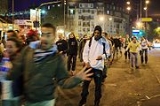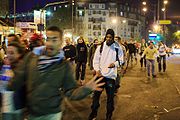
Road skating
Encyclopedia
Road skating is the sport
of skating (inline skating
or roller skating
) on road
s, much like road cycling
. It shares much with Inline speed skating
.
Roadskaters often skate in tight packs, drafting each other and sharing the lead, which allows a pack to travel faster than an individual skater. The individual members of a pack use comparatively less energy than the lone skater traveling at the same speed. Even the lead skater in the pack enjoys an advantage from the drafting skaters behind.
While gliding downhill, an inline skater in a tucked position can achieve speeds that exceed the speed of a tucked cyclist. This is due to lower wind resistance. The rolling resistance is similar for a cyclist and a skater — it is only when actively skating (i.e., in the skating stroke) that the skater incurs greater resistance. Skating is roughly 50% slower than cycling on flat ground.
Skaters routinely achieve downhill speeds of 60 km/h (37 mph), similar to cyclists. Compared to cyclists, though, skaters particularly suffer on uphills, when the drafting advantage disappears.
A skating paceline going down hills may easily achieve speeds faster than a cycling paceline of equal length. The reason is that the road skating paceline has a much more efficient draft effect. The draft effect in road skating is superior for three reasons:
 Street skating is the practice of roller skating
Street skating is the practice of roller skating
(commonly on inline skates
or quad skates
) in groups on public roads. Street skates can be formal affairs, with prespecified routes, marshals and, at times, police
escorts or ad hoc gatherings of like minded individuals.
There are organized street skates in a number of cities around the world. Some of the largest are in Paris (the 'Pari Roller') , Munich
and Berlin. London also has an active street skating scene. LondonSkate runs free events on Wednesday evenings; and a smaller scene can be found in Nottingham.
Such events may involve several hundred participants, so to minimize disruption to other road users the events are usually operated in coordination with the police and other relevant local authorities, such as bus operators. Therefore, the route must be decided in advance. Volunteer marshals help to control traffic at busy junctions. Their goals are to minimize disruption to all road users and to ensure the safety of the skaters.
These events are usually free to enter. Normally, the only requirement is that each individual skater can keep pace with the rest of the group and can turn and stop safely. Participants that don't meet these requirements are usually asked to leave the skate and encouraged to practice their skating skills for a few days and return to the next street skate event.
Individuals skate at their own risk and would be legally liable for any damage they might cause to other peoples' property.
Sport
A Sport is all forms of physical activity which, through casual or organised participation, aim to use, maintain or improve physical fitness and provide entertainment to participants. Sport may be competitive, where a winner or winners can be identified by objective means, and may require a degree...
of skating (inline skating
Inline skating
Inline skating is a recreational sport practiced widely internationally. Inline skates typically have 2 to 5 polyurethane wheels, arranged in a single line. The in-line design allows for greater speed than roller skates and better maneuverability...
or roller skating
Roller skating
Roller skating is the traveling on smooth surfaces with roller skates. It is a form of recreation as well as a sport, and can also be a form of transportation. Skates generally come in two basic varieties: quad roller skates and inline skates or blades, though some have experimented with a...
) on road
Road
A road is a thoroughfare, route, or way on land between two places, which typically has been paved or otherwise improved to allow travel by some conveyance, including a horse, cart, or motor vehicle. Roads consist of one, or sometimes two, roadways each with one or more lanes and also any...
s, much like road cycling
Road cycling
Road cycling is the most widespread form of cycling. It includes recreational, racing, and utility cycling. Road cyclists are generally expected to obey the same rules and laws as other vehicle drivers or riders and may also be vehicular cyclists....
. It shares much with Inline speed skating
Inline speed skating
Inline speed skating is the sport of racing on inline skates It is often called inline racing by participants. Although it primarily evolved from racing on traditional roller skates, the sport is similar enough to ice speed skating that many competitors are now known to switch between inline and...
.
Roadskaters often skate in tight packs, drafting each other and sharing the lead, which allows a pack to travel faster than an individual skater. The individual members of a pack use comparatively less energy than the lone skater traveling at the same speed. Even the lead skater in the pack enjoys an advantage from the drafting skaters behind.
While gliding downhill, an inline skater in a tucked position can achieve speeds that exceed the speed of a tucked cyclist. This is due to lower wind resistance. The rolling resistance is similar for a cyclist and a skater — it is only when actively skating (i.e., in the skating stroke) that the skater incurs greater resistance. Skating is roughly 50% slower than cycling on flat ground.
Skaters routinely achieve downhill speeds of 60 km/h (37 mph), similar to cyclists. Compared to cyclists, though, skaters particularly suffer on uphills, when the drafting advantage disappears.
A skating paceline going down hills may easily achieve speeds faster than a cycling paceline of equal length. The reason is that the road skating paceline has a much more efficient draft effect. The draft effect in road skating is superior for three reasons:
- each skater can be much closer to the person in front of her, whereas each cyclist is limited by the distance of the wheels;
- each skater gaining inertia energyEnergyIn physics, energy is an indirectly observed quantity. It is often understood as the ability a physical system has to do work on other physical systems...
from being in the draft can translate this energy to the person in front of her by maintaining contact (usually by placing a hand on the lower back of the person in front); and - the skater has much less equipment-related aerodynamic drag than the cyclist.
Cross training
Skating (especially road skating) is much more like cycling than running in terms of the muscles employed. Cyclists and skaters commonly participate in each other's sports as cross-training. Runners often switch to road skating due to injuries associated with the impact of running. Many skiers use road skating for off-season and pre-season conditioning as well. In addition, skating is an excellent cross-training activity for a wide range of other sports due to the lateral (side-to-side) motion involved in the skating stride.Drafting
Road skating in a pack has some common rules that most skaters follow. Such rules include skating in single file except when passing or moving into the back of the pack, rotational "pulling" in the front of the pack to shield the rest of the pack from the wind, and signaling about road conditions, hazards and alike to skaters in the back of the pack. Single-file skating in a pack is mostly dictated by the need to minimize the impact of air resistance on the pack, thus shielding from the wind behind the back of the first person who is "pulling" the pack. "Pulling" is associated with up to 30% higher energy exertion; thus, it is generally accepted that skaters rotate through "pulls," allowing for equal energy exertion through the pack. A skater who has finished "pulling" steps out of the pack and slowly moves into the back of the pack. The skater in front of the pack has a better view of the road ahead and points and calls out road hazards (holes, cracks, water puddles, cars, etc.).Street skating

Roller skating
Roller skating is the traveling on smooth surfaces with roller skates. It is a form of recreation as well as a sport, and can also be a form of transportation. Skates generally come in two basic varieties: quad roller skates and inline skates or blades, though some have experimented with a...
(commonly on inline skates
Inline skates
In-line skates are a type of roller skate used for inline skating. Unlike quad skates, which have two front and two rear wheels, inline skates have two, three, four, or five wheels arranged in a single line...
or quad skates
Quad skates
The four-wheeled turning roller skate, or quad skate, with four wheels set in two side-by-side pairs, was first designed in 1863 in New York City by James Leonard Plimpton in an attempt to improve upon previous designs. The skate contained a pivoting action using a rubber cushion, and this allowed...
) in groups on public roads. Street skates can be formal affairs, with prespecified routes, marshals and, at times, police
Police
The police is a personification of the state designated to put in practice the enforced law, protect property and reduce civil disorder in civilian matters. Their powers include the legitimized use of force...
escorts or ad hoc gatherings of like minded individuals.
There are organized street skates in a number of cities around the world. Some of the largest are in Paris (the 'Pari Roller') , Munich
Munich
Munich The city's motto is "" . Before 2006, it was "Weltstadt mit Herz" . Its native name, , is derived from the Old High German Munichen, meaning "by the monks' place". The city's name derives from the monks of the Benedictine order who founded the city; hence the monk depicted on the city's coat...
and Berlin. London also has an active street skating scene. LondonSkate runs free events on Wednesday evenings; and a smaller scene can be found in Nottingham.
Such events may involve several hundred participants, so to minimize disruption to other road users the events are usually operated in coordination with the police and other relevant local authorities, such as bus operators. Therefore, the route must be decided in advance. Volunteer marshals help to control traffic at busy junctions. Their goals are to minimize disruption to all road users and to ensure the safety of the skaters.
These events are usually free to enter. Normally, the only requirement is that each individual skater can keep pace with the rest of the group and can turn and stop safely. Participants that don't meet these requirements are usually asked to leave the skate and encouraged to practice their skating skills for a few days and return to the next street skate event.
Individuals skate at their own risk and would be legally liable for any damage they might cause to other peoples' property.
Friday Night Skate
A Friday Night Skate (often abbreviated to FNS) is a group skate occurring on Friday nights, a common night for a street skate in many cities throughout the world.External links
- Homepage Friday Night Skate Amsterdam
- Street skates in London, from OpenGuides
- Friday Night Skate Copenhagen
- Street Skates in Israel (+Tel Aviv Rollers Tuesday night skate)
- The Midnight Rollers: San Francisco's Friday Night Skate
- Wednesday Night Skate New York City
- Los Angeles Friday Night Skate
- Skate Calendar
- Berlin Skate By Night
- PIN, Odessa, Ukraine.
- Roadskater.Net.
- Pari Roller.
- London Wednesday Night Skate.

